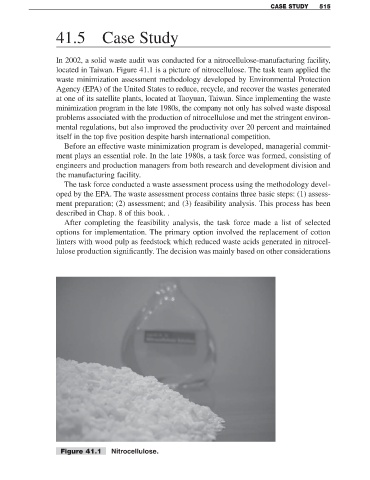Page 537 - Solid Waste Analysis and Minimization a Systems Approach
P. 537
CASE STUDY 515
41.5 Case Study
In 2002, a solid waste audit was conducted for a nitrocellulose-manufacturing facility,
located in Taiwan. Figure 41.1 is a picture of nitrocellulose. The task team applied the
waste minimization assessment methodology developed by Environmental Protection
Agency (EPA) of the United States to reduce, recycle, and recover the wastes generated
at one of its satellite plants, located at Taoyuan, Taiwan. Since implementing the waste
minimization program in the late 1980s, the company not only has solved waste disposal
problems associated with the production of nitrocellulose and met the stringent environ-
mental regulations, but also improved the productivity over 20 percent and maintained
itself in the top five position despite harsh international competition.
Before an effective waste minimization program is developed, managerial commit-
ment plays an essential role. In the late 1980s, a task force was formed, consisting of
engineers and production managers from both research and development division and
the manufacturing facility.
The task force conducted a waste assessment process using the methodology devel-
oped by the EPA. The waste assessment process contains three basic steps: (1) assess-
ment preparation; (2) assessment; and (3) feasibility analysis. This process has been
described in Chap. 8 of this book. .
After completing the feasibility analysis, the task force made a list of selected
options for implementation. The primary option involved the replacement of cotton
linters with wood pulp as feedstock which reduced waste acids generated in nitrocel-
lulose production significantly. The decision was mainly based on other considerations
Figure 41.1 Nitrocellulose.

